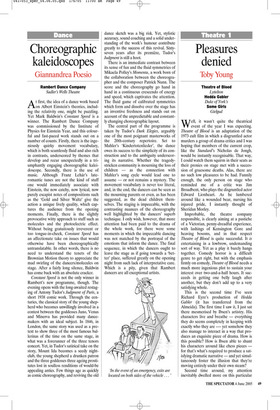Choreogra p hic
kaleidoscopes
Giannandrea Poesio
Rambert Dance Company Sadler’s Wells Theatre
At first, the idea of a dance work based on Albert Einstein’s theories, including the relativity one, might be puzzling. Yet Mark Baldwin’s Constant Speed is a winner. The Rambert Dance Company was commissioned by the Institute of Physics for Einstein Year, and this colourful and fast-paced work stands out on a number of counts. Firstly, there is the ingeniously quirky movement vocabulary, which is both seamlessly fluid and also rich in contrasts, underscored by themes that develop and recur unexpectedly in a triumphantly engaging choreographic kaleidoscope. Secondly, there is the use of music. Although Franz Lehár’s lateromantic tunes are not the kind of stuff one would immediately associate with Einstein, the now catchy, now lyrical, now purely escapist notes of compositions such as the ‘Gold and Silver Waltz’ give the action a unique lively quality, which captures the audience from the opening moments. Finally, there is the slightly provocative witty approach to stuff such as molecules and the photoelectric effect. Without being gratuitously irreverent or too tongue-in-cheek, Constant Speed has an affectionate take on issues that would otherwise have been choreographically untranslatable. In other words, there is no need to understand the tenets of the Brownian Motion theory to appreciate the mad swirling of the dancers/molecules on stage. After a fairly long silence, Baldwin has come back with an absolute cracker.
Constant Speed is not the only winner in Rambert’s new programme, though. The evening opens with the long-awaited restaging of Antony Tudor’s Judgment of Paris, a short 1938 comic work. Through the centuries, the classical story of the young shepherd who becomes unwillingly involved in a contest between the goddesses Juno, Venus and Minerva has provided many dancemakers with an ideal subject. In 1846, in London, the same story was used as a pretext to show three of the most famous ballerinas of the time on the same stage, in what was a forerunner of the three tenors concert. Yet, in Tudor’s satirical take on the story, Mount Ida becomes a seedy nightclub, the young shepherd a drunken patron and the three goddesses three ageing prostitutes lost in soulless renditions of would-be appealing antics. Few things age as quickly as comic choreography, and reviving the old dance sketch was a big risk. Yet, stylistic accuracy, sound coaching and a solid understanding of the work’s humour contribute greatly to the success of this revival. Sixtyseven years after its première, Tudor’s Judgment is still a hoot.
There is an immediate contrast between its sense of fun and the fluid symmetries of Mikaela Polley’s Momenta, a work born of the collaboration between the choreographer and the composer Patrick Nunn. The score and the choreography go hand in hand in a continuous crescendo of energy and speed, which captivates the attention. The fluid game of calibrated symmetries which form and dissolve over the stage has an inventive freshness and stands out on account of the unpredictable and constantly changing choreographic layout.
The central part of the programme is taken by Tudor’s Dark Elegies, arguably one of the most poignant masterworks of the 20th-century repertoire. Set to Mahler’s ‘Kindertotenlieder’, the dance owes its success to the simplicity of its construction and to the ambiguity underscoring its narrative. Whether the tragedystricken community is mourning the loss of children — as the connection with Mahler’s song cycle would lead one to assume — or not remains a mystery. The movement vocabulary is never too literal, and, in the end, the dancers can be seen as the mourning parents or even, as has been suggested, as the dead children themselves. The staging is impeccable, with the contrasting nuances of the choreography well highlighted by the dancers’ superb technique. I only wish, however, that more attention had been paid to the drama of the whole work, for there were some moments in which the impeccable dancing was not matched by the portrayal of the emotions that inform the dance. The final sequence, in which the dancers ought to leave the stage as if going towards a ‘better’ place, suffered greatly on the opening night from such lack of interpretative care. Which is a pity, given that Rambert dancers are all exceptional artists.


















































 Previous page
Previous page